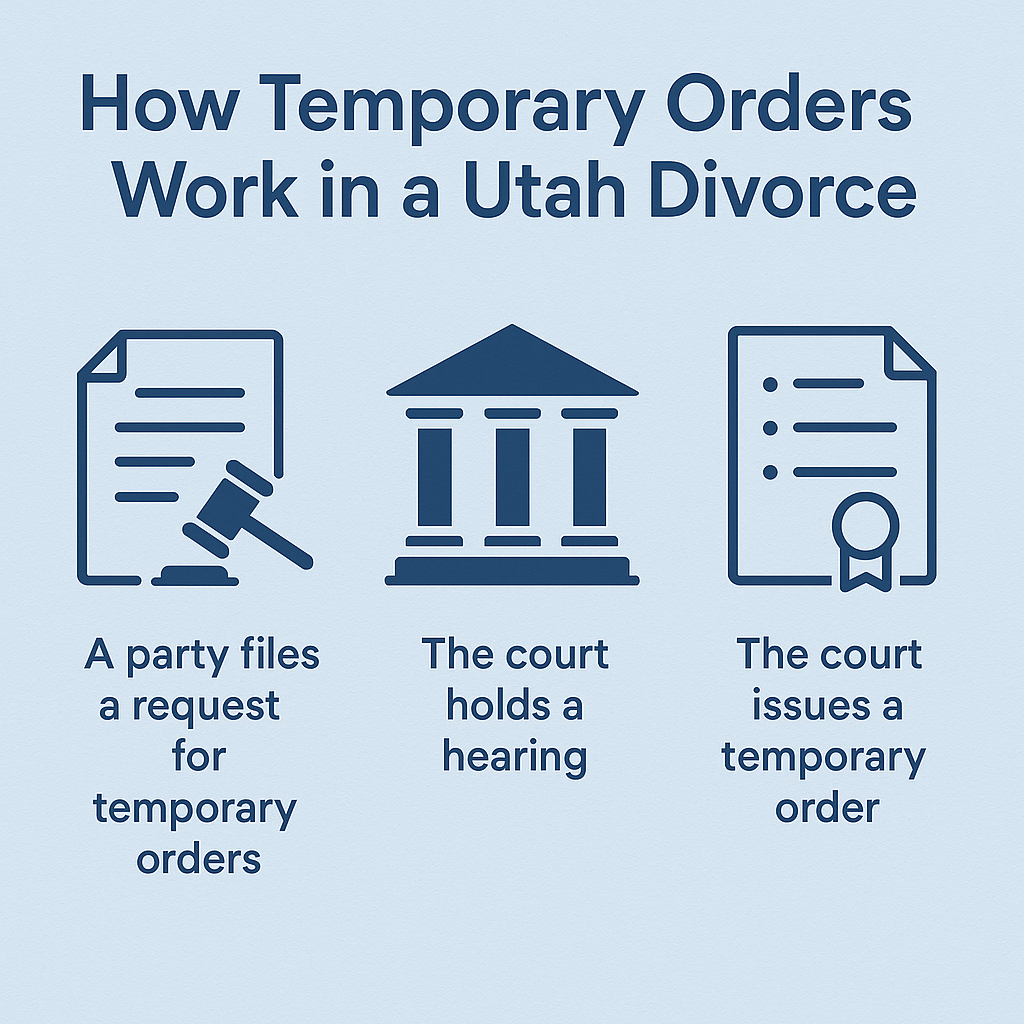How Do Temporary Orders Work In a Utah Divorce?
Plain-English answers on what they cover, how to request them, emergency orders, evidence, changes, and enforcement
Utah Law Explained breaks down temporary orders: short-term court decisions that keep life stable while your divorce is pending. Judges use them to set housing, support, parent-time, and who pays ongoing bills until the final decree.
Either spouse can ask for them after filing for divorce. The judge issues orders to manage immediate needs so things do not spiral while the case moves forward.
What Are Temporary Orders?
They are short-term rulings that apply during the case. They do not decide the final outcome, but they set the ground rules so both sides can function.
Housing & Bills
Who stays in the home, who uses a shared vehicle, and who pays mortgage, insurance, or utilities.
Money Support
Temporary child support and spousal support based on verified income and expenses.
Kids & Schedules
Temporary custody and parent-time to keep the children’s routine steady.
Property Protections
Restraints on selling property or draining accounts to prevent harm before trial.
Judges issue these to prevent financial or emotional chaos while the case is pending.
How Do You Request Temporary Orders?
File a Motion for Temporary Orders
File in the same court where your divorce is pending. Use local motion forms and include a short explanation of what you need and why.
Attach Financial Disclosures
Include income, expenses, debts. Add pay stubs, bank statements, and tax returns where helpful.
Serve the Other Party
Follow service rules so your motion is properly noticed. Improper service can delay the hearing.
Attend the Hearing (If Set)
Be concise and fact focused. Bring printed copies of your filings and evidence.
Most counties follow similar procedures. Clear, documented requests get better results.
Emergency vs. Regular Temporary Orders
Emergency (Ex Parte)
Regular Motion
What Evidence Helps Your Request?
Judges decide based on written declarations, financial disclosures, and sometimes live testimony. Clarity beats emotion.
Accuracy and organization matter. Label exhibits and keep a clean timeline.
How Long Do They Last? How To Modify or Enforce
Temporary orders stay in place until the final divorce decree replaces them, or until the court modifies them. Divorce cases can take months, so expect these to run for a while.
Change in Circumstances
Lost job or relocation? File a Motion to Modify Temporary Orders and explain the change with documents.
Noncompliance
If orders are ignored, file a Motion for Order to Show Cause. Judges can issue fines, fees, or other remedies.
Stay Organized
Track payments, keep messages, and save receipts. Good records make modification and enforcement easier.
Common Mistakes To Avoid
- Forgetting financial evidence or filing incomplete disclosures
- Missing filing or service requirements
- Assuming the court will grant everything requested without proof
- Skipping hearings or not responding to motions
- Relying on emotion instead of clear facts
Being timely, factual, and well documented makes a major difference.
Helpful Resources
Local Support
Video & Social Learning Hub
Key Takeaways
Temporary orders stabilize housing, money, and parenting while a Utah divorce is pending.
File a Motion for Temporary Orders with solid financial proof and clear requests.
Emergency ex parte orders are for immediate risk and get reviewed at a quick follow-up hearing.
Modify if circumstances change and enforce with an Order to Show Cause if orders are ignored.
This page is legal information, not legal advice. When in doubt, get counsel before you file.
Need Help Applying This to Your Situation?
Every family’s facts are different. If you are unsure what to request or how to respond, a short consult can help you present strong, organized evidence.
Talk to a Utah AttorneyWe can help you frame support numbers, craft parent-time proposals, and prepare for hearings.
